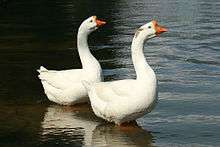Chinese goose


The Chinese goose is a breed of domesticated goose descended from the wild swan goose. Chinese geese differ from the wild birds in much larger size (up to 5–10 kg in males, 4–9 kg in females), and in having an often strongly developed basal knob on the upper side of the bill. The knob at the top of the beak is more prominent on males than females. By 6–8 weeks of age, the knob is already pronounced enough that it can be used for determining gender. Chinese geese are a close cousin of the African goose, a heavier breed also descended from the swan goose.
Chinese geese appear in two varieties: a brown similar to the wild swan goose and white. While many domestic Chinese geese have a similar body type to other breeds, the breed standards as defined in the American Poultry Association's Standard of Perfection and other sources call for a slimmer, taller fowl.[1]
Chinese geese are among the better laying breeds of goose. A female Chinese goose can lay 50–60 eggs over the course of the breeding season (February to June), although there are reports of Chinese geese laying up to 100 eggs during that time.[2]
Footnotes
References
- Ekarius, Carol (2007). Storey's Illustrated Guide to Poultry Breeds. 210 MAS MoCA Way, North Adams MA 01247: Storey Publishing. ISBN 978-1-58017-667-5.
- Buckland, Roger & Guy, Gérard (eds.) (2002): Goose Production. FAO Animal Production and Health Papers 154. ISBN 92-5-104862-2 PDF fulltext
- "Chinese Geese". feathersite.com. Retrieved 2008-07-02.